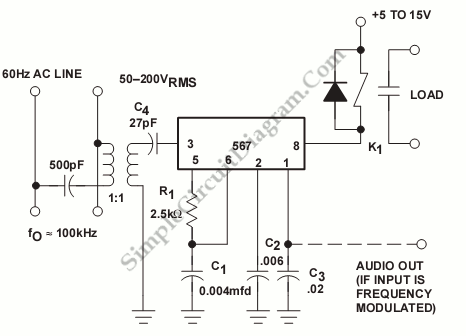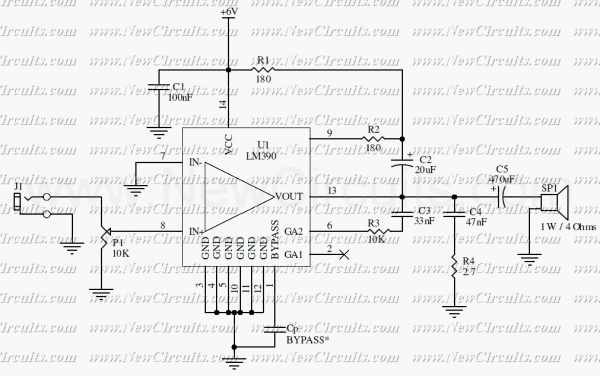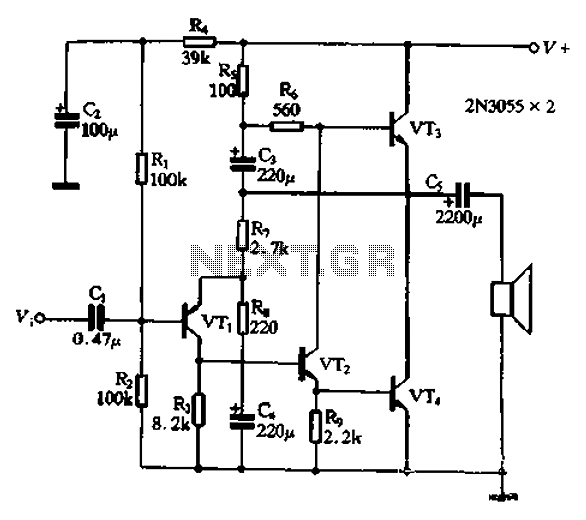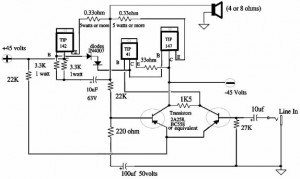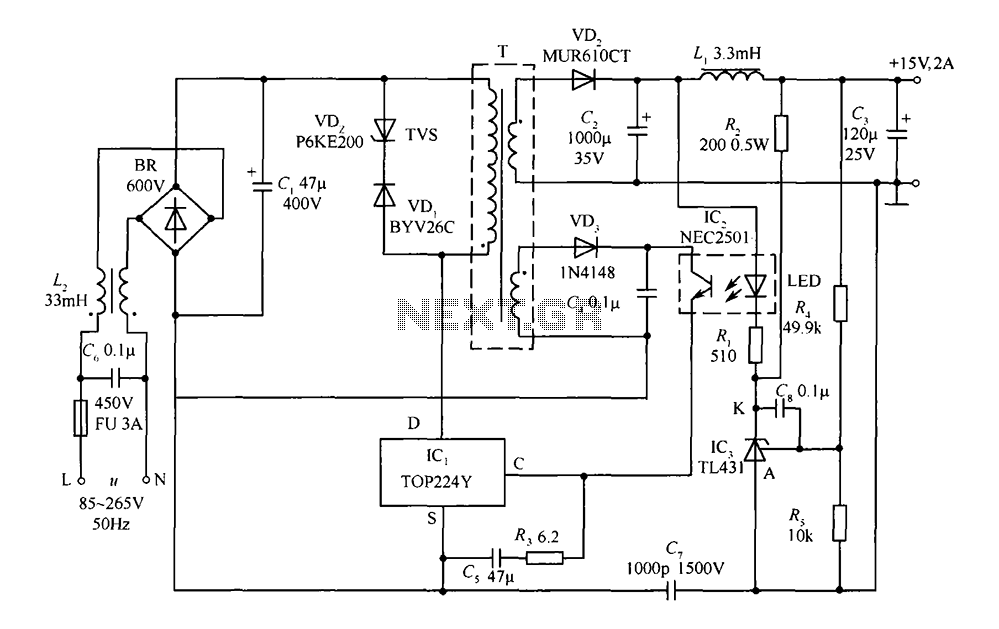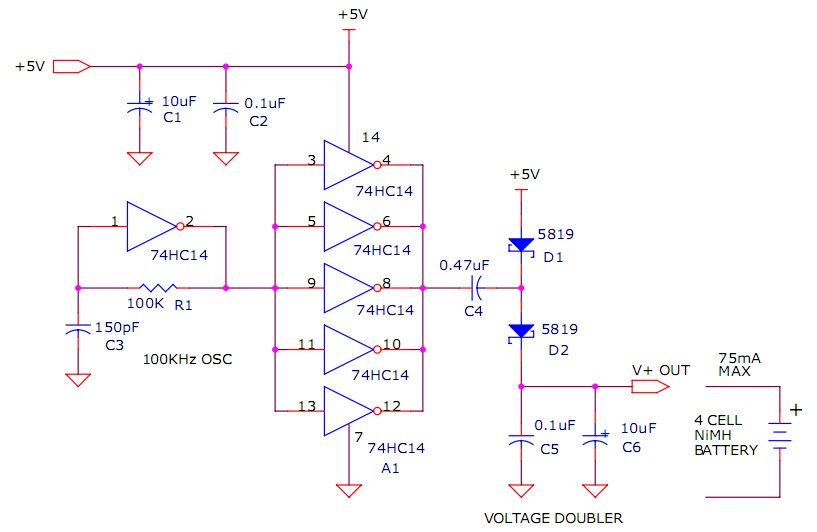
Power Audio Amplifier based on STK400xx
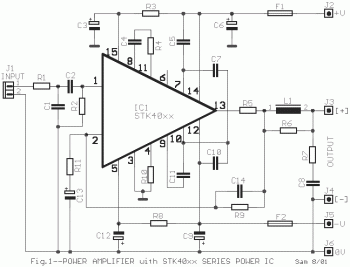
This is a power audio amplifier circuit based on the STK400xx series. It provides high-quality sound and is cost-effective, as the STK40xx series is affordably priced. The circuit can be easily constructed using only a few external components. The STKxxxx amplifiers are commonly found in various stereo amplifiers and active loudspeakers. Minimal specialized knowledge is required for assembly; however, careful attention must be paid to the pins to avoid damage, and a suitable power supply is essential.
The power audio amplifier circuit utilizing the STK400xx series is designed to deliver high-fidelity sound output while remaining budget-friendly. The STK400xx series integrates several functions into a single package, which simplifies the design process and reduces the number of external components required. Typically, the circuit consists of the STK power amplifier IC, a few passive components such as resistors and capacitors, and a heat sink to manage thermal dissipation.
To construct this amplifier circuit, the following key components are necessary:
1. **STK400xx Amplifier IC**: This integrated circuit is the heart of the amplifier, providing the necessary amplification of audio signals. It is available in various configurations, allowing for different power outputs and impedance matching.
2. **Power Supply**: A well-regulated power supply is crucial for the performance of the amplifier. The voltage and current ratings must match the specifications of the STK400xx series to ensure optimal operation. Typically, a dual power supply providing both positive and negative voltages is used.
3. **Input and Output Coupling Capacitors**: These capacitors are used to block DC voltage while allowing AC audio signals to pass through. They help in preventing any DC offset from reaching the speakers, which could potentially damage them.
4. **Feedback Resistors**: These components set the gain of the amplifier and help stabilize the circuit. Proper selection of resistor values is essential for achieving the desired performance characteristics.
5. **Heat Sink**: Given that power amplifiers can generate significant heat during operation, a heat sink is necessary to dissipate this heat and prevent thermal overload of the amplifier IC.
When assembling the circuit, it is imperative to follow the pin configuration outlined in the STK400xx datasheet to avoid damaging the IC. Additionally, ensuring proper grounding and layout can significantly enhance the performance and reliability of the amplifier.
This circuit design is widely applicable in audio applications, including home audio systems, car audio, and public address systems, making it a versatile choice for audio amplification needs.This is Power Audio Amplifier circuit based on STK400xx series. It`s will give you very good quality of sound this circuit is unexpensive too since STK40xx series have low price. It is easy we make a power amplifier using only few external components. The STKxxxx amplifiers, for them we will find in enough eponymous stereo amplifiers, but also i n enough activety loudspeakers. They do not need a lot of special knowledge of manufacture, only that attention in pins, in order to they do not break, and one good power supply. 🔗 External reference
The power audio amplifier circuit utilizing the STK400xx series is designed to deliver high-fidelity sound output while remaining budget-friendly. The STK400xx series integrates several functions into a single package, which simplifies the design process and reduces the number of external components required. Typically, the circuit consists of the STK power amplifier IC, a few passive components such as resistors and capacitors, and a heat sink to manage thermal dissipation.
To construct this amplifier circuit, the following key components are necessary:
1. **STK400xx Amplifier IC**: This integrated circuit is the heart of the amplifier, providing the necessary amplification of audio signals. It is available in various configurations, allowing for different power outputs and impedance matching.
2. **Power Supply**: A well-regulated power supply is crucial for the performance of the amplifier. The voltage and current ratings must match the specifications of the STK400xx series to ensure optimal operation. Typically, a dual power supply providing both positive and negative voltages is used.
3. **Input and Output Coupling Capacitors**: These capacitors are used to block DC voltage while allowing AC audio signals to pass through. They help in preventing any DC offset from reaching the speakers, which could potentially damage them.
4. **Feedback Resistors**: These components set the gain of the amplifier and help stabilize the circuit. Proper selection of resistor values is essential for achieving the desired performance characteristics.
5. **Heat Sink**: Given that power amplifiers can generate significant heat during operation, a heat sink is necessary to dissipate this heat and prevent thermal overload of the amplifier IC.
When assembling the circuit, it is imperative to follow the pin configuration outlined in the STK400xx datasheet to avoid damaging the IC. Additionally, ensuring proper grounding and layout can significantly enhance the performance and reliability of the amplifier.
This circuit design is widely applicable in audio applications, including home audio systems, car audio, and public address systems, making it a versatile choice for audio amplification needs.This is Power Audio Amplifier circuit based on STK400xx series. It`s will give you very good quality of sound this circuit is unexpensive too since STK40xx series have low price. It is easy we make a power amplifier using only few external components. The STKxxxx amplifiers, for them we will find in enough eponymous stereo amplifiers, but also i n enough activety loudspeakers. They do not need a lot of special knowledge of manufacture, only that attention in pins, in order to they do not break, and one good power supply. 🔗 External reference
